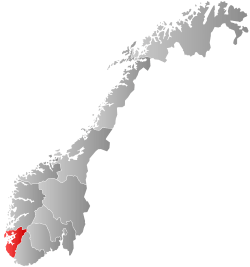Jelsa (municipality)
Jelsa is a former municipality in Rogaland county, Norway. The 130-square-kilometre (50 sq mi) municipality existed from 1838 until 1965. It encompassed area that surrounds the Sandsfjorden in the present-day municipalities of Suldal, Hjelmeland, and Stavanger. The administrative centre was the village of Jelsa, where Jelsa Church is located.[1]
Jelsa herred | |
|---|---|
 View of Jelsa Church, the main church for the municipality | |
 Rogaland within Norway | |
 Jelsa within Rogaland | |
| Coordinates: 59°20′N 06°04′E | |
| Country | Norway |
| County | Rogaland |
| District | Ryfylke |
| Established | 1 Jan 1838 |
| Disestablished | 1 Jan 1965 |
| Administrative centre | Jelsa |
| Area | |
| • Total | 130 km2 (50 sq mi) |
| *Area at municipal dissolution. | |
| Population (1965) | |
| • Total | 1,025 |
| • Density | 7.9/km2 (20/sq mi) |
| Time zone | UTC+01:00 (CET) |
| • Summer (DST) | UTC+02:00 (CEST) |
| ISO 3166 code | NO-1138 |
| Created as | Formannskapsdistrikt in 1838 |
| Succeeded by | Suldal, Hjelmeland, and Finnøy in 1965 |
History
The parish of Jælse was established as a municipality on 1 January 1838 (see formannskapsdistrikt law). In 1859, the municipality was split, with the northern district becoming the municipality of Sand. The split left Jelsa with a population of 2,606. On 1 January 1914, the eastern district was split off as the new municipality of Erfjord. This left Jelsa with 1,539 residents.[2]
On 1 January 1965 the municipality of Jelsa was dissolved due to recommendations by the Schei Committee. The majority of Jelsa (population: 928) was merged with the municipalities of Erfjord, Sand, and Suldal to form a new, enlarged Suldal Municipality. At the same time, the Buergårdene area (population: 8) on the island of Ombo was moved to Hjelmeland Municipality, and the rest of the island of Ombo that belonged to Jelsa (population: 89) was moved to Finnøy Municipality.[2]
Government
All municipalities in Norway, including Jelsa, are responsible for primary education (through 10th grade), outpatient health services, senior citizen services, unemployment and other social services, zoning, economic development, and municipal roads. The municipality is governed by a municipal council of elected representatives, which in turn elects a mayor.[3]
Municipal council
The municipal council (Herredsstyre) of Jelsa was made up of 17 representatives that were elected to four year terms. The party breakdown of the final municipal council was as follows:
| Party Name (in Norwegian) | Number of representatives | |
|---|---|---|
| Labour Party (Arbeiderpartiet) | 3 | |
| Christian Democratic Party (Kristelig Folkeparti) | 6 | |
| Centre Party (Senterpartiet) | 8 | |
| Total number of members: | 17 | |
| Party Name (in Norwegian) | Number of representatives | |
|---|---|---|
| Labour Party (Arbeiderpartiet) | 4 | |
| Joint List(s) of Non-Socialist Parties (Borgerlige Felleslister) | 9 | |
| Local List(s) (Lokale lister) | 4 | |
| Total number of members: | 17 | |
| Party Name (in Norwegian) | Number of representatives | |
|---|---|---|
| Local List(s) (Lokale lister) | 17 | |
| Total number of members: | 17 | |
| Party Name (in Norwegian) | Number of representatives | |
|---|---|---|
| Local List(s) (Lokale lister) | 16 | |
| Total number of members: | 16 | |
| Party Name (in Norwegian) | Number of representatives | |
|---|---|---|
| Local List(s) (Lokale lister) | 16 | |
| Total number of members: | 16 | |
| Party Name (in Norwegian) | Number of representatives | |
|---|---|---|
| Local List(s) (Lokale lister) | 16 | |
| Total number of members: | 16 | |
| Party Name (in Norwegian) | Number of representatives | |
|---|---|---|
| Local List(s) (Lokale lister) | 16 | |
| Total number of members: | 16 | |
References
- Store norske leksikon. "Jelsa – tidligere kommune" (in Norwegian). Retrieved 19 May 2015.
- Jukvam, Dag (1999). "Historisk oversikt over endringer i kommune- og fylkesinndelingen" (PDF) (in Norwegian). Statistisk sentralbyrå.
- Hansen, Tore, ed. (12 May 2016). "kommunestyre". Store norske leksikon (in Norwegian). Kunnskapsforlaget. Retrieved 13 July 2020.
- "Kommunevalgene 1963" (PDF) (in Norwegian). Oslo: Statistisk sentralbyrå. 1964. Retrieved 30 July 2020.
- "Kommunevalgene og Ordførervalgene 1959" (PDF) (in Norwegian). Oslo: Statistisk sentralbyrå. 1960. Retrieved 30 July 2020.
- "Kommunevalgene og Ordførervalgene 1955" (PDF) (in Norwegian). Oslo: Statistisk sentralbyrå. 1957. Retrieved 30 July 2020.
- "Kommunevalgene og Ordførervalgene 1951" (PDF) (in Norwegian). Oslo: Statistisk sentralbyrå. 1952. Retrieved 30 July 2020.
- "Kommunevalgene og Ordførervalgene 1947" (PDF) (in Norwegian). Oslo: Statistisk sentralbyrå. 1948. Retrieved 30 July 2020.
- "Kommunevalgene og Ordførervalgene 1945" (PDF) (in Norwegian). Oslo: Statistisk sentralbyrå. 1947. Retrieved 30 July 2020.
- "Kommunevalgene og Ordførervalgene 1937" (PDF) (in Norwegian). Oslo: Statistisk sentralbyrå. 1938. Retrieved 30 July 2020.

